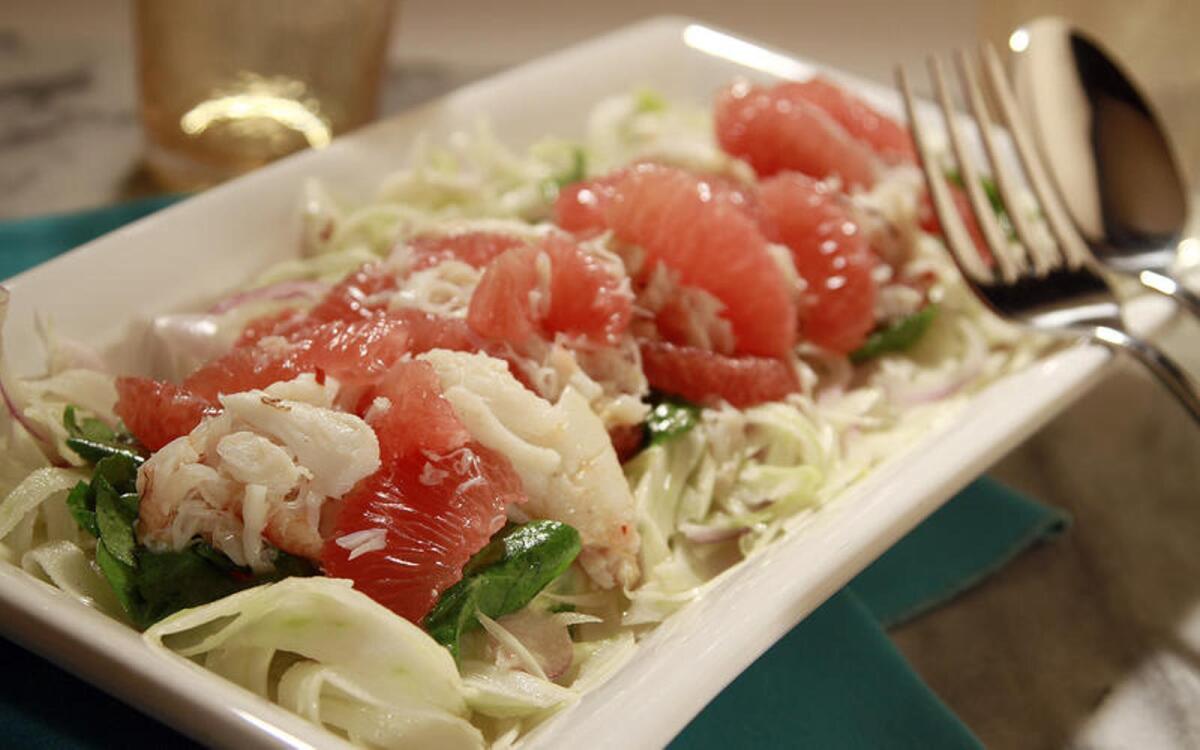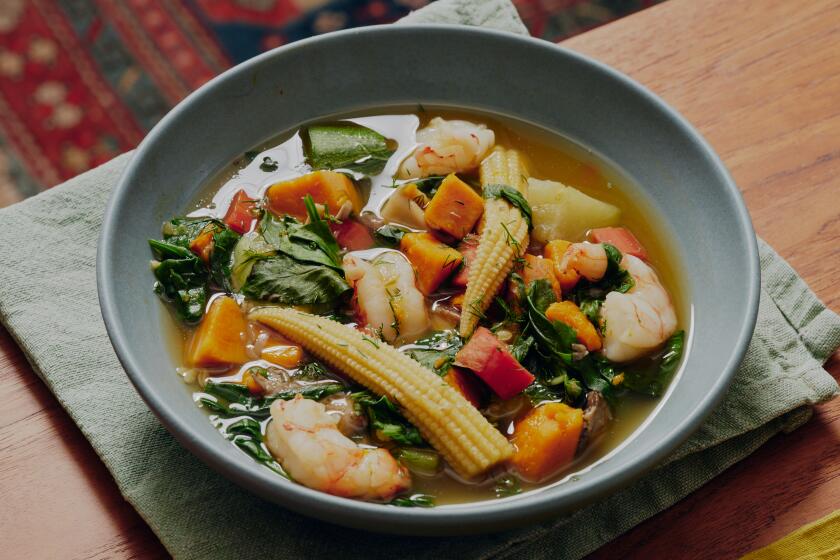Pink grapefruit and fennel salad with crab

- Share via
The cook’s year can be divided in two: tomato and not-tomato. But sometimes, even the best-intentioned, most locavore-crazy among us so crave a sweet, tart bite in our salads that we break down and grab one of those cottony out-of-season tennis balls. You’ve done it too. Don’t try to deny it.
In some cases, though, there’s an easy alternative. Because happily for us, beneficent nature has ensured that the not-tomato months pair up perfectly with the drowning-in-citrus ones. And in a lot of dishes, a little bit of citrus will give you just what you were hankering for -- certainly a lot better than an out-of-season tomato.
This is not a universal solution by any means. I’m trying to picture laying a slice of grapefruit on top of my hamburger. But it does work out often enough that it’s worth exploring.
The first time I tried it was more or less by accident. It was dinner time, and I had some lettuce and some cheese. And not much else. But wait, my neighbors Don and Carol had dropped off a sack of tangerines from their tree -- perfectly balanced between tart and sweet. What if I put some of those in the salad along with some hazelnuts?
I tried it first with crumbled blue cheese, which seemed kind of a natural because they are so often served together. Wrong. The citrus seemed to bring out every bit of bitterness in the Gorgonzola. And when you taste the cheese that way, there is actually quite a lot.
Then my wife suggested trying the same salad with some fresh goat cheese. Amazing. The combination, dressed with a vinaigrette made with hazelnut oil and Champagne vinegar, harmonized perfectly. (Hint: When making a vinaigrette with hazelnut oil, cut it with an equal amount of canola or another neutral oil -- it’s just too rich on its own.)
And then my little cook’s mind started racing. What other combinations might work? There’s the now-classic combination of beets and blood oranges, of course. Though you’re just as likely to see navels, Cara Caras or even grapefruit, all used to great effect and demonstrating that, though all citrus are different from each other, they’re not that different. For recipe purposes, use what you have, they’re fairly interchangeable.
A couple of nights later, faced with the happy dilemma of having some leftover Dungeness crab (I have no idea how that happened), I shaved some fennel very thin and made another salad with wedges of pink grapefruit and some torn-up arugula from my garden.
The only trick to this salad is cutting the grapefruit -- it’s called “supremeing” in kitchen parlance (you have to say it like a Frenchman or it sounds like you’re doing a Diana Ross imitation). You slice off the top and bottom of the whole fruit, then cut off the rest of the peel, carefully following the line of the flesh. Then you slice free each grapefruit segment, separating it from the tougher membrane. This isn’t necessary with more tender citrus, such as tangerines, but with grapefruit and oranges, it’s a good idea. And once you get the hang of it, it’s a nice little Zen exercise.
Those are just a couple of examples. I have to admit that at this point I have the feeling I’ve just scratched the surface. I’m sure I’ll find some more. We’ve still got a couple of not-tomato -- er, citrus -- months left.
Peel the grapefruit and cut it into sections: Using a very sharp knife, cut off the top and the bottom of the grapefruit, so it will sit flat on the cutting board. Starting where you see the pink grapefruit separate from the white pith, cut away one section of peel and pith, following the line of the fruit. This will expose the underlying fruit. Continue cutting away sections of the peel and pith until only fruit remains. When you’re done, go back over the fruit, removing any traces of pith.
Working over a small bowl to catch the juice, slice the fruit into sections -- make a cut between the fruit and membrane, then do the same on the other side, freeing pure fruit. Repeat until you have removed all the fruit from the membrane. Squeeze any juice from the remaining membrane into the bowl. You will need about 2 tablespoons
Quarter the fennel lengthwise and remove the triangular core at the center. Use a mandolin or a very sharp knife to slice the fennel as thin as possible, about one-eighth inch; you’ll have about 3 cups, lightly packed. Do the same with the red onion; you’ll have about one-half cup. Combine the fennel and red onion in a large bowl.
Add one-half teaspoon salt and the red pepper flakes to the reserved grapefruit juice and whisk in the olive oil.
Toss the fennel with just enough of the dressing to lightly moisten it. Arrange the fennel on a platter in a low mound.
Add the arugula to the same bowl and toss to moisten it; you may need to add another teaspoon of vinaigrette. Arrange the arugula on top of the fennel.
Add the grapefruit and crabmeat to the same bowl and toss very gently to avoid breaking up the citrus or the crab. You want it barely moistened; if you need, add another teaspoon of vinaigrette. Arrange this on top of the arugula and serve immediately.
Get our Cooking newsletter.
Your roundup of inspiring recipes and kitchen tricks.
You may occasionally receive promotional content from the Los Angeles Times.
















